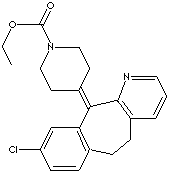|
Antihistamine is a group of drugs characterized by the ability to block the
action of histamines on H1 receptors. The principal use is to treat allergies,
hives, and other local and systemic hypersensitivity reactions. Some
antihistamines can also be used in the control of insomnia, motion sickness, or
vertigo. First-generation antihistamines can cause side effect of sedation.
Second-generation antihistamines (fexofenadine, loratadine) are nonsedating.
Loratadine is a white to off-white powder; insoluble in water; soluble in
acetone, alcohol, and chloroform. It is chemically described as
4-(8-chloro-5,6-dihydro-11H-benzo[5,6] cyclohepta [1,2-b]pyridin- 11-ylidene)-
1-piperidinecarboxylate, ethyl ester.
It is used an H1 receptor antagonist; administered orally. |
